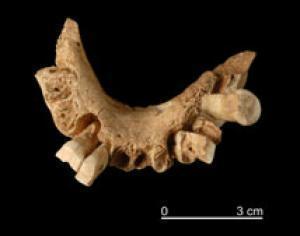The find shows that members of the genus Homo, to which modern humans belong, colonized the region much earlier than previously believed. Details of the discovery were published in the March 27 issue of the journal Nature.

|
| ©EIA/Jordi Mestre |
| Top view of the mandible ATE 9-1. |
The fossil - a small piece of jawbone with a few teeth - was found last year in a cave in the mountains of northern Spain, along with primitive stone tools and bones of animals that appear to have been butchered.
The team, led by Spanish researchers Juan Luis Arsuaga, José María Bermúdez de Castro and Eudald Carbonell, used three separate techniques (including paleomagnetic analyses performed by Pares) to determine that the fossil is about 1.2 million years old. That's 500,000 years older than the previous oldest known humanlike fossils from the area. The new find bolsters the view that Homo reached Europe not long after leaving Africa almost 2 million years ago.
"It seems probable that the first European population came from the region of the Near East, the true crossroads between Africa and Eurasia, and that it was related to the first demographic expansion out of Africa," said Pares, who is a research scientist in the U-M Department of Geological Sciences and program director of the newly created National Research Center on Human Evolution (CENIEH) in Burgos, Spain, with which most of the authors are affiliated.
The researchers tentatively classified the new fossil as an earlier example Homo antecessor (Pioneer Man), the species represented by the previous oldest fossils and thought to be the last common ancestor of Neanderthals and modern humans.
"This is a very significant advance toward a better understanding of the nature, age and protagonists of the first European human settlement," Pares said.
Adapted from materials provided by University of Michigan.



Reader Comments
to our Newsletter